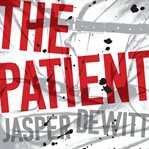FLICKER They cut all the loonies loose. They never told us why. And if they told any of the loonies why, no loony ever told me. Which wouldn't be surprising, I guess. Despite all that time cooped up with them, I never spoke to the loonies much and they never spoke to me. I think once you hear my story you'll acknowledge that I was never really one of them. I was a moth caught in their butterfly net, pinned for a time to the same page, a stammering yammering mess, looking for my lost lad. It was because I joined with Father Julius right away, see, that I didn't come to traffic with them on the outside. He was the first person I met on the outside, Julius--a happy accident. Otherwise, I might have run with the loonies just for want of options, and then wound up in the same boat as them later. Then again, look at the boat we're in now. I expect the loonies were as confused as I was to get tossed out. I gath-ered the story later, on the outside. It was in all the papers. Politics. Some lady named Fritz with more clout than sense. At the time, I didn't care about any of it. All I knew was I was outdoors, looking for a roof over my head and a willing ear--that's how it was when I lucked into Father Julius. ♦♦♦ "Loony Island" isn't a true island; civic planning composes its borders, not water. Still, as Father Julius sees it, it's earned the name. A forgotten wedge of a neighborhood, both hidden from the city and hidden by the city: long ago a secluded hill-perched purlieu of the rich overlooking the very center of the city and the interstate highway, now a forgotten place seemingly en-gineered for quarantine, cut off to the east by a steep bank leading down to the muddy Loony River, and embraced all around by a hard-to-negotiate concrete park of abandoned factories, and by the less permeable element of social indifference. At the north end, a public transport trestle runs (withoutstopping) west to east until it rolls over the Loony, a wide and turbid river carrying sticks and mud and alleged industrial waste south. At the "island's" southern point, the river runs beneath an interstate highway, making an acute angle. From this confluence, the highway carries cars (but never any cars from Loony Island, which is afforded no on-ramp) away to the south-east, or up north and west until it dips and runs beneath the transport trestle, completing a triangle--river and highway and trestle--from whose borders most of its denizens rarely if ever depart. Seen from the air by passengers on their way to somewhere else, its shape might briefly suggest an abandoned slice of hastily cut pizza--a slice partitioned into quadrants by two main roads, Apse St. and Transept Ave., and surrounded by a gray donut of shut-tered factories. Cross-like, Apse and Transept intersect nearly exactly in the neighborhood's maudlin middle, escaping it through narrow gaps running beneath highway and rail--though not to the east; in Loony Island, no road reaching the river receives tunnel or bridge. If you have a car, making your way north or west is easy enough at first, but you'll find that these ways lead only into the rotted industrial ring, tailing off into lots that haven't seen a truck in years, designed to accommodate warehouse docks that haven't seen inventory for just as long. Transept's southbound course carries you out of the neighborhood--it's the only one that does--but you have to patiently fol-low a road that needlessly wends switchback down a hill of moderate grade before passing out of the factory district and finally--finally!--to a main thoroughfare connected to the rest of the city. If you don't have a car, you've got to hoof it for the bus stops (no buses' routes go out of their way for the Island), risking encounters with the bad sorts who lurk in narrow places and the dark parts of shuttered buildings, or who wait around curves--and the skeptical eyes, and the confident hands and elbows and knees, of bluebirds in their squad cars. Most here don't have a car. Most stay put. And, it must be admitted, some stay put not because of lack of transport, but because they aren't given any legal choice. Take, for example, the inmates of JAWPI--the Joan A. Wales Psychiatric Institute--"The Wales"--bones of steel, flesh of concrete, skin of brick, clothed in industrial green paint. A hulking rectilinear cracker box, it hugs Transept Ave. for unbroken cityblocks in the southeast quadrant, some blocks south of the main intersection. The Wales is the most prominent building in Loony Island, and its presence might lead ruminative souls to question--is the placement of a loony bin here a sly joke by some waggish urban engineer? Was the neighborhood bequeathed its name because of its inmates, or did it gain inmates because of the nearby Loony River? The majority of Loony Island's population lives in Domino City, six ne-glected high-rise urban housing complexes standing at surly attention west of the Wales on the other side of Transept. Identical gray concrete slabs filling most of the southwest quadrant, visible for uncomfortable minutes to commuters in cars gliding past on the highway. In Domino City, every build-ing has a name and a gang, and each gang its own specialty and jurisdiction. They all used to war for dominance over one another, but that was years ago, before Ralph Mayor took control. Ralph's General & Specific is his store; a monopoly made inevitable by isolation. Ralph's is smaller than the Dominos but no less important to the criminal ecosystem, and you'll find it situated right at the central intersection. Ralph's got the goods, and Ralph's got the organization, and Ralph has managed to put the fear of Ralph into the heart of every other roughneck, so Ralph's is where business--any business--gets done. Everything north of Apse is nothing but Checkertown: a tessellated patchwork grid of streets whose parcels hold century-old houses gone to sag and ruin or over-ambitious partition into apartments by absentee landlords, or burned-out vacant lots, or the occasional liquor store--and also Father Julius's Neon Chapel. The Neon, a large two-story building, its construction of a more recent vintage than that of its neighbors, is located on the north end of Checkertown, up near the rail. Leave the Neon and cross Transept, and you can bowl at Barney's Suds & Lanes, if you care to bowl. Few do, but there are still a few working stiffs who'll groove a ball or two down those flaking aisles--they mostly come up from Slanty's Cannery after shifts let off. Slanty's, the only factory inexplicably still open, operates in the southern tip of the "slice," hard by the river. It's a lot to ponder, if you're the sort to ponder. Father Julius, running in early morning light, passing from one errandto another, cresting the southern Transept switchback at a formidable pace, squinting as morning sun peeks out between buildings on his right, subcon-sciously avoiding open manholes and uneven sidewalks, can't help but pon-der: What, exactly, are the implications of all this architecture? Settled into a haze of comfortable exertion, he considers a pet theory: the neighborhood as an assembly line, with insanity the product. It's not so hard to imagine. These brutalist buildings were built for efficiency and utility, after all, much like any factory system. He's seen too many in the neighborhood lose hope living in the gray slabs of Domino City, get initiated into the gangs--either as member or as customer or as product--and matriculate from there to the Wales or to prison, or from one to the other. Close your eyes, you can see it: the young, sluiced down the chute, sprayed with disinfecting insanity, and then, with factory precision, canned and packed and stacked away, first made systemically unsightly, then warehoused out of sight. Incarceration not an indicator of some breakdown in the system, you understand, but a func-tion of the system working precisely toward intended purposes. There's a lone gangster sitting on the sidewalk, abandoned by his fellows after a night drinking, bleary-eyed, carefully breathing himself sober. Miser-able business, to be sure, but even in his headspun misery he turns his head to watch Julius chug by--impossible not to mark a figure like Julius, his beard a magnificent tangle edging without border into the unkempt jungle atop his scalp, the whole thicket framing the smiling white half-moon of his teeth and the brown twinkle of his eyes, his only garments the denim robe shielding his barrel of a body and the dirty sneakers anointing his boatlike feet--he's buff, vital, a creature swimming in the present, holding reliably to his routine. The routine. It's the same every day. Father Julius has his errands and he runs from one to the next. If you're the type to rise early, you can watch for him. He's coming from the first errand--the secret one, the off-Island one. If anyone knows where it takes place, or what business is transacted there, they aren't talking, and neither is he. Now he's heading to the Wales, where he'll minister to the mentally ill--an attempt to fulfill the patients' innate need for non-clinical interaction. He reads whatever they request, which, when he's lucky, means romance or spy or mystery novels from the Wales' modest library, but which in practice almost always means reading the requestingpatient's manifesto. "Recognize the gods offered Magilla the Gorilla for a reason," Julius might find himself proclaiming in his gravel truck of a voice, the patient listening enraptured by the novelty of hearing their own words marbling the mouth of another. "She freely admitted there were multiples, just as there are multiples of your favorite baseball heroes. Apes in particular may be Planet Earth's 'acceptable losses.' The Magilla model suggests you are many branches from enlightenment." And so forth. Julius hopes for mystery novels. Excerpted from The Revisionaries by A. R. Moxon All rights reserved by the original copyright owners. Excerpts are provided for display purposes only and may not be reproduced, reprinted or distributed without the written permission of the publisher.



